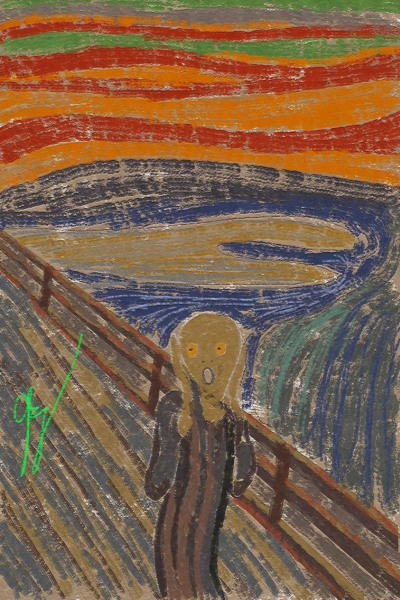
Why is The Scream painting so famous?
Few works of art in history evoke as much intrigue and emotion as The Scream, the iconic painting by Norwegian artist Edvard Munch. First created in 1893, The Scream is more than just a painting, it is a cultural phenomenon, a visual shorthand for existential angst, and a symbol that transcends its time. But why is this work so famous? Let’s explore the factors that contributed to its enduring legacy.
A Striking Visual Language
One of the most striking aspects of The Scream is its arresting visual composition. Munch’s use of swirling, almost chaotic lines creates a dynamic sense of motion and unease. The central figure, with its androgynous, ghost like appearance and mouth agape in an eternal scream, is both specific and universal. The vibrant orange sky, set against the dark, sinuous lines of the fjord below, creates a surreal landscape that mirrors the internal turmoil of the subject.
This innovative use of color and form was groundbreaking for its time, departing from the realistic depictions of the natural world that dominated 19th century art. Instead, Munch painted emotion itself, paving the way for the Expressionist movement. By portraying an internal state rather than an external reality, The Scream invites viewers to project their own feelings of fear, anxiety, or despair onto the canvas.
A Personal Narrative
The origins of The Scream are deeply personal to Munch. The artist described a moment of overwhelming existential dread that inspired the work. In his diary, he recounted walking along a fjord in Oslo, then Kristiania as the sun set, when he suddenly felt “a great infinite scream pass through nature.” This vivid description offers a glimpse into Munch’s psyche and his lifelong struggles with mental health, which were shaped by personal tragedies, including the early deaths of his mother and sister.
This deeply personal connection imbues the painting with an authenticity that resonates universally. Munch’s ability to transform his private anguish into a public statement about the human condition is one reason The Scream continues to captivate audiences around the world.
Cultural and Historical Context
When Munch created The Scream, the world was undergoing profound changes. The late 19th century was a time of rapid industrialization, urbanization, and scientific discovery. These shifts brought about a sense of alienation and anxiety for many, themes that are palpable in the painting. The figure’s isolated position on the bridge, surrounded by an almost indifferent natural and human world, reflects the alienation that many people felt during this era of transformation.
Additionally, The Scream emerged at a pivotal moment in art history. The work’s raw emotionalism and break from traditional artistic techniques influenced the Expressionist movement, which sought to depict subjective experiences rather than objective reality. Artists like Wassily Kandinsky, Egon Schiele, and Ernst Ludwig Kirchner drew inspiration from Munch’s willingness to explore the darker aspects of the human psyche.
A Multi Version Masterpiece
One lesser known fact about The Scream is that it exists in several versions. Munch created two painted versions, two pastels, and a number of lithographs. Each version carries subtle differences, offering unique interpretations of the same harrowing scene. This multiplicity allowed The Scream to reach wider audiences during Munch’s lifetime and contributed to its widespread recognition today.
The pastel version created in 1895 sold for a staggering $120 million at auction in 2012, underscoring the artwork’s value not only as a cultural artifact but also as a commodity in the global art market.
Symbolism and Universality
The ambiguous figure in The Scream is one of its most compelling features. Neither male nor female, the figure represents humanity as a whole. Its open mouthed scream, simultaneously heard and unheard, resonates on a primal level, capturing a universal human experience, the raw, unfiltered response to fear, despair, or existential uncertainty.
The painting’s symbolism extends beyond the central figure. The fiery sky has been interpreted as a reflection of Munch’s own inner turmoil or even as an allusion to atmospheric phenomena like the Krakatoa volcanic eruption of 1883, which caused vividly colored sunsets worldwide. These layers of meaning invite endless interpretation, ensuring the work remains relevant across generations.
Pop Culture and Memes
In modern times, The Scream has achieved a level of fame few artworks can match. Its haunting image has been parodied and reimagined countless times, appearing in everything from movies and cartoons to advertisements and internet memes. This ubiquity has cemented its status as a cultural touchstone. While some might argue that such widespread reproduction diminishes its artistic value, it has also ensured that the painting remains a part of contemporary discourse.
Theft and Recovery
Another factor contributing to the painting’s fame is its dramatic history of thefts. In 1994, the version housed in the National Gallery of Norway was stolen during the Winter Olympics in Lillehammer. Although it was recovered later that year, the audacious heist brought international attention to the artwork. In 2004, another version of The Scream was stolen from the Munch Museum in Oslo and was recovered two years later. These thefts added an aura of mystery and intrigue to the painting, further fueling public fascination.
The Scream as a Mirror
Ultimately, the enduring fame of The Scream lies in its ability to act as a mirror for the human experience. Its raw emotionality, coupled with its striking visual style, allows it to transcend time, geography, and culture. Whether viewed as a masterpiece of Expressionism, a personal cry for help, or a symbol of modern anxiety, The Scream continues to resonate because it speaks to something fundamental about what it means to be human.
In a world that often feels overwhelming, The Scream tells us that we are not alone in our fears and uncertainties. It is this universality, combined with its groundbreaking artistry and fascinating history, that ensures Edvard Munch’s magnum opus will remain one of the most famous and beloved works of art for generations to come.





